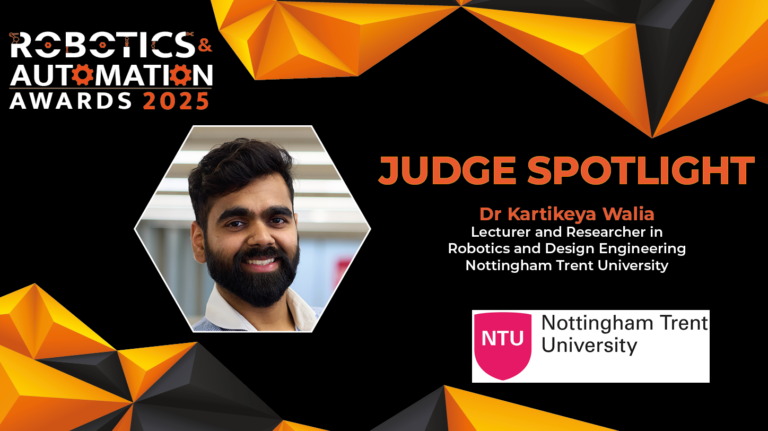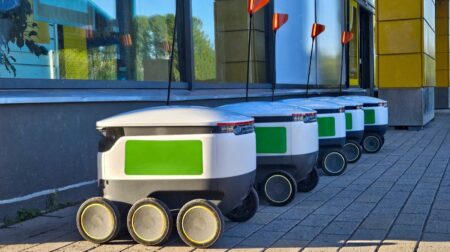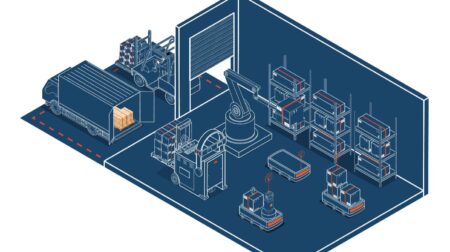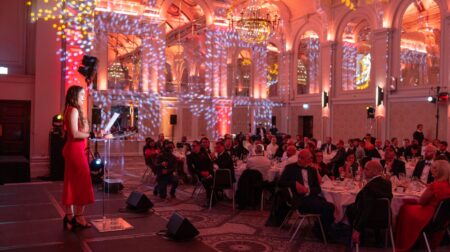With entries for Robotics & Automation Awards 2025 now open, Robotics & Automation Magazine has launched an exclusive series of Q&A interviews with the expert panel of judges responsible for evaluating this year’s submissions.
Over the coming weeks and months, the magazine will spotlight each judge – a dynamic mix of thought leaders, technical specialists, and business strategists drawn from across the robotics, automation, AI and smart manufacturing sectors – to explore their backgrounds, industry outlooks and what they’ll be looking for in an award-winning entry.
From end users and integrators to researchers and investors, this year’s panel represents a diverse blend of practical and academic expertise – all of which will help identify the most transformative, scalable, and commercially viable innovations driving the next era of automation and intelligent systems.
Our next judge is Kartikeya Walia, lecturer and researcher in robotics and design engineering at Nottingham Trent University. He also has a focus on additive manufacturing.
His research spans industrial and medical robotics, including collaborations with PepsiCo during his PhD.
He supervises PhD projects in humanoid and surgical robotics and has industry experience in automation. He is involved in international collaborations on generative design for robotic systems, has received the Open Research Award, and has shared insights on sustainability in robotics on Notts TV.
He works at the intersection of academia and industry, contributing to advancements in automation and robotics.
Name: Kartikeya Walia
Job title: Lecturer and Researcher in Robotics and Design Engineering
Organisation: Nottingham Trent University
How does your professional background align with the Robotics & Automation Awards’ goal of recognising excellence in automation and intelligent technologies?
As a lecturer and researcher in design engineering at Nottingham Trent University, my work focuses on the convergence of robotics, additive manufacturing, and automation. I’ve collaborated with industry partners like PepsiCo, supervised PhD projects on surgical and humanoid robots, and developed modular robotic systems with sustainability and usability in mind. This blend of academic depth and industrial relevance aligns closely with the Awards’ aim to celebrate innovations that have both technical excellence and real-world impact.
What current trends or technologies in robotics and automation are you most excited about, and how do you anticipate seeing them reflected in this year’s entries?
I’m particularly excited by the integration of generative design in robotics, the rise of collaborative and soft robotics, and increased attention to sustainability—both in design and lifecycle. I also see growing interest in modularity and reconfigurability, which enable faster deployment and adaptation. I expect to see entries that combine intelligence with accessibility—solutions that not only push technological boundaries but also consider ease of use, environmental impact, and scalability.
From your perspective as a judge, what qualities will distinguish a truly standout submission?
A standout submission will go beyond technical novelty. It should demonstrate a clear understanding of the problem it addresses, articulate how it delivers value—whether through improved performance, efficiency, or user experience—and provide evidence of real-world application or commercial potential. I’ll also look for thoughtful design decisions, particularly those that consider human factors, manufacturability, and long-term sustainability.
How do industry awards such as these help foster innovation, investment and commercialisation in the robotics and automation sector?
Industry awards play a key role in showcasing emerging technologies, validating new ideas, and building visibility for innovators—especially those from smaller companies or research-led teams. They create a platform to connect with potential partners, investors, and end-users, helping to accelerate the journey from concept to commercial product. Recognising and rewarding excellence also sets benchmarks that inspire future development.
Can you share an example of a robotics or automation innovation – either recent or historic – that you believe has had a lasting impact on the way industries operate?
An historic example would be the introduction of the Universal Robots UR series—collaborative robotic arms—was a game-changer. By making industrial automation accessible to SMEs and allowing safe human-robot collaboration, they transformed how automation is perceived and implemented across sectors. This shift toward flexible, user-friendly automation paved the way for more inclusive and adaptive robotic solutions.
What advice would you give to companies and individuals submitting an entry this year?
Tell the story behind your innovation—what problem are you solving, and why does it matter? Be clear about the impact, whether it’s efficiency, sustainability, accessibility, or market disruption. Use evidence—real data, feedback, or case studies—where possible, and don’t be afraid to highlight the challenges you faced. Often, the path to innovation is as impressive as the outcome.
Achievements and innovations in retail and e-commerce, healthcare and pharmaceuticals, food and beverage, automotive, transport & logistics, and more will be celebrated at the Robotics & Automation Awards on 29 October 2025 at De Vere Grand Connaught Rooms in London. Visit www.roboticsandautomationawards.co.uk to learn more about this unmissable event for the UK’s robotics and automation sectors!






